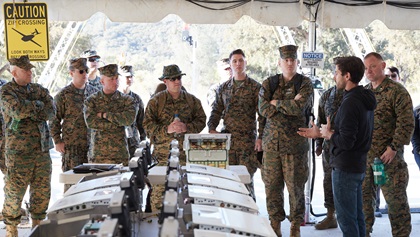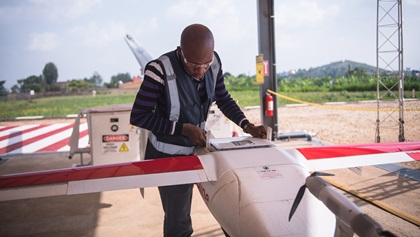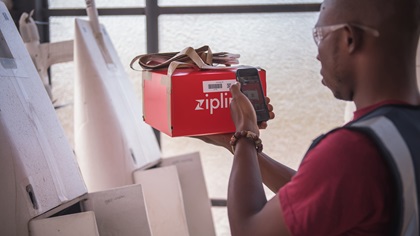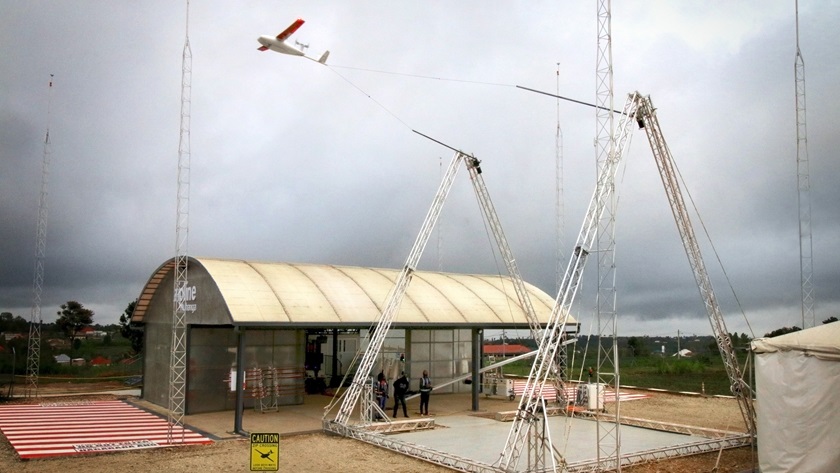Zipline pitches drones for US coronavirus relief
BVLOS flights could scale up fast if FAA approves
Zipline has flown medical delivery drones in Africa for years, and now the company that credibly claims more long-distance drone experience than any civilian competitor is asking the FAA to allow unmanned flights in the national airspace system to bolster the coronavirus pandemic response.
Zipline was already lined up to bring its bespoke, fixed-wing delivery drones to U.S. skies before the COVID-19 pandemic arrived.
Zipline plans to introduce its UAS to the United States in the fall as part of North Carolina’s advanced testing program that is part of the federal Integration Pilot Program. The company also has worked with the U.S. Department of Defense on various exercises in the United States and Australia, according to the firm’s global communications chief, Justin Hamilton, who detailed the plans and pitch in a recent phone and email conversation. Hamilton said Zipline collaborated with the U.S. Marine Corps and Department of Defense “to show how autonomous, on-demand drone delivery can be used to help save lives on the battlefield and respond to humanitarian and disaster relief scenarios.”
Zipline’s drones have autonomously flown more than 2 million miles to date, Hamilton said, most of that crisscrossing African skies carrying blood and other medical deliveries to connect remote clinics with larger health facilities. The company also claims credit for the longest flight beyond the operator’s visual line of sight in the continental United States to date, a 79-mile round trip at an average speed of 64 miles per hour. Hamilton would not detail the locations covered, other than noting a “U.S. military base” was involved. “We, on a pretty regular basis, are flying 100 miles a pop.”

As U.S. cities including New York, its largest, struggle to cope with the pandemic, Zipline has fielded requests from health care providers and government entities at the local, state, and federal levels to implement its system in the United States. “As a result, we, along with those I’ve just mentioned, have approached the FAA to see how we can do that as quickly as possible,” Hamilton said, adding that there has been “conversation at every level of the agency” on this topic, and Zipline hopes the FAA will exercise emergency authority to allow potentially lifesaving flights by unmanned aircraft.
“There is an urgent need,” Hamilton said, “and we’re ready to begin helping as quickly as possible.”
Zipline created and continues to operate six distribution centers in Ghana and Rwanda, unmanned aircraft bases that form an aerial logistics network that serves more than 20 million people, Hamliton said. Zipline’s drones have transformed health care in those countries, increasing access to rare blood products by 175 percent in Rwanda, “while reducing waste to zero,” Hamilton added, noting that the global average for blood products that go to waste because they are not delivered in time to where they are needed is around 6 percent.
“We’ve been able to do for health care what Toyota did for automotive manufacturing,” Hamilton said, referring to the concept of just-in-in-time inventory management pioneered by the Japanese automaker in the 1970s.
Hamilton said Zipline is prepared to tackle the challenge of standing up drone delivery networks anywhere in the United States, including the hard-hit New York region.
“We have the capacity to serve urban, suburban, and rural areas alike,” Hamilton said. “We believe that from the moment we’re given a green light, we could begin operations within just a couple of weeks.”
Hamilton said Zipline could expand to serve a large portion of the country within about a year.
A big step up in complexity
Zipline has a credible claim to being the most experienced and successful drone delivery company in the world, but its impressive list of superlatives cries out for some context when contemplating the firm’s offer to fast-track long-distance drone delivery: Zipline has done most of its flying in some of the least crowded airspace on the planet.
Even with air traffic cut nearly in half (so far) by the ongoing coronavirus pandemic, the United States likely still leads the world in several air transportation statistics, including air traffic operations. By just about any measure, U.S. airspace is more crowded, by orders of magnitude, than both Ghana and Rwanda.

According to The World Factbook published by the Central Intelligence Agency, Rwanda occupies a geographic area slightly smaller than Maryland, with an air transport infrastructure that includes seven airports, four of them with paved runways, and one air carrier registered with the civil aviation authority that operates nine aircraft. The CIA publication lists 2015 data for annual passenger traffic: 645,815. The corresponding numbers for the United States in that same source are significantly larger: In 2015, the United States had 92 registered air carriers operating 6,817 aircraft and carrying nearly 800 million passengers.
Comparing the 2015 CIA data to 2018 FAA data, Rwanda’s 2015 passenger totals are similar to the 2018 passenger statistics for individual airports in Asheville, North Carolina (573,206), and Burlington, Vermont (658,879).
Ghana, slightly smaller than Oregon in terms of geographic area, had four air carriers with eight aircraft between them, and seven airports serving 390,457 passengers in 2015, according to the CIA publication. That’s a few more passengers than Tallahassee International Airport in Florida logged in 2018, according to FAA data.
Zipline is developing a proprietary detect-and-avoid system that would allow its autonomous UAS to “see” and avoid other aircraft, though the company does not propose to field that in the near term. Hamilton declined to describe that system.
Risk mitigation strategy
Zipline’s concept of operations in the two African nations has not required DAA capability for its many BVLOS operations. In a video posted in 2019 highlighting Zipline’s safety measures, co-founder Keenan Wyrobek describes technologies including preflight inspections aided by computers, and various backup systems in the aircraft that contribute to “making and operating the safest system of its kind in the world.”
Each of Zipline’s fixed-wing UAS have redundant power, propulsion, navigation, and communications systems; an airframe parachute that can be deployed in an emergency is “the system we are most proud of,” Wyrobek said in the video, referring to its potential uses in the event of weather, system failures, or other events.

“For example, aviation authorities may tell us to clear the skies in an emergency,” Wyrobek said, an apparent reference to potential deconfliction instructions from air traffic control.
Hamilton said that the company has not proposed implementing onboard DAA technology in the near term, reserving deployment of Zipline’s custom-made solution for later, when the company begins operations in North Carolina under that state’s UAS Integration Pilot Program effort.
“We would deploy ADS-B [I]n on drones for immediate emergency operations,” Hamilton wrote in a follow-up email responding to questions about risk mitigation. “That plus DAA would be deployed for regular operations after the fall launch.”
The FAA has approved a relatively small number of waivers to date allowing civil UAS operations in the NAS, all with risk mitigations that include airspace surveillance capable of locating aircraft known to UAS engineers as “non-cooperative,” meaning aircraft that are not broadcasting their position via ADS-B, or other electronic means. It remains to be seen if the FAA’s cost-benefit analysis will allow approval of BVLOS flights by UAS without onboard DAA capability, or other risk mitigations used to date including radar surveillance, and planning UAS flight routes and altitudes that take advantage of surrounding terrain or obstacles to reduce or eliminate the possibility of conflict with manned aircraft.
Potential rewards
While Zipline’s public pitch may seem a little thin on risk mitigation, from a pilot’s perspective, the potential rewards could be tempting to a federal government struggling to keep pace with a pandemic.
Hamilton noted that the worst outbreaks to date have severely stressed the health care system at all levels, from first responders to hospital intensive care units. Reducing that stress is one of the firm’s primary objectives.
“We have to find a way to extend the reach of the hospital into the home,” Hamilton said. People living with chronic conditions often need access to prescription drugs and hands-on health care, and Zipline offers a potential solution to both that eliminates a visit to a facility where an at-risk patient faces potential coronavirus infection. Hamilton said that Zipline drones could potentially deliver medical diagnostic tools that facilitate remote sensing and telemedicine, as well as medications prescribed.
Zipline’s delivery drones could also help create an aerial supply chain for distribution of medicine, blood, and personal protective equipment to areas facing severe shortages caused by an influx of COVID-19 patients. Many locations are struggling with shortages of blood, even if the COVID-19 incidence remains relatively low; the nearly ubiquitous stay-at-home advisories have significantly reduced blood donations. Efficient distribution of scarce resources is Zipline’s core mission.
Finally, there will come a day (hopefully sooner than later, but most likely at least a year in the future) when a vaccine is ready to distribute. There, too, Zipline sees a role. Hamilton noted that the vaccine will take time to mass produce in sufficient volume to inoculate every person, and there will likely be a period of time, possibly lasting many months, where outbreaks will flare up.
“You will have to target a very, very scarce commodity to those areas, almost immediately and in real time,” Hamilton said. “That’s something we do every day.”





